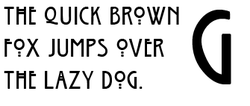Willow (typeface)
Willow is a name shared by two typefaces.
ITC Willow
 | |
| Category | Decorative |
|---|---|
| Designer(s) | Tony Forster |
| Foundry | ITC |
 | |
| Sample | |
ITC Willow was designed by Tony Forster in 1990. Although a contemporary typeface, Willow is the reminiscent of the Scottish Arts and Crafts style made popular by painter and social reformer Jessie Marion King (1875–1949), and architect and designer Charles Rennie Mackintosh (1868–1928) of the Glasgow School. The face is based upon a sign for the Willow Tea Room, one of three tea rooms in Glasgow designed by Mackintosh. The typeface is distinct for the double crossbars on the uppercase A and H, and the unusual design of the uppercase O, which is raised above the baseline, with two dots centred beneath the bowl.
Willow Regular
| Category | Display |
|---|---|
| Designer(s) | Joy Redick |
| Foundry | Adobe Type |
Willow Regular was designed by Joy Redick in 1990, and is part of the Adobe Originals Woodtype Collection.
Popular culture
The TV show American Horror Story features a variant of ITC Willow* prominently in the episodes as well as the series logotype itself.
- The font used was actually a slightly edited version of The Charles Rennie Mackintosh Font, which was purchased specifically to use on the show. This features a modified letter "O" and slightly closer character spacing than the original. Its use was notable among TV/movie buffs since it has never been regarded as synonymous with the "horror" genre.
The Charles Rennie Mackintosh Font was also used in the motion picture Spider-Man 2. It featured in the display signage for the Broadway play (Oscar Wilde's "The Importance of Being Earnest") in which Mary Jane Watson (Kirsten Dunst), Peter Parker's on-off girlfriend, was appearing. The movie's director, Sam Raimi, spent some time in Glasgow, Scotland, at the Glasgow School of Art, the institute attended by (and later re-designed by) Charles Rennie Mackintosh himself. Raimi became a big fan of Mackintosh's work and specifically asked for this font to be used in the making of the signage. Other huge admirers of Mackintosh's work are Hollywood superstars Brad Pitt and Angelina Jolie, who made an impromptu visit to the Hill House in Helensburgh, Scotland, during Pitt's visit to Glasgow where he was filming the movie "World War Z".
See also
External links
- The Willow Tea Room with photo of the sign the typeface is based upon
- "ITC Willow". ITC.
- "Willow Font Family". Linotype.